ANISOTA OF THE WORLD
|
|
Updated as per Lemaire's Ceratocampinae 1988, September 28, 2006
Updated as per Entomo Satsphingia, Jahrgang 7 Heft 3 30.09.2014; December 6, 2014
|
ANISOTA OF THE WORLD
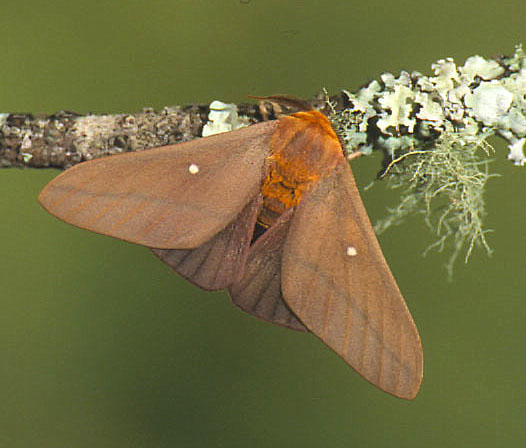
Anisota assimilis. Photo by Leroy Simon.
ANISOTA Hubner, [1820]
Males of this genus have quadripectinate antennae, are generally smaller than the females,
and tend to be diurnal, resembling bees in flight due to a relatively large hyaline area on the
forewing.
Most species occur in the southeastern United States, but a few occur
further west and into Mexico.
The females have simple ciliate antennae and tend to
nocturnally oviposit clusters of 15-50 yellow-orange ova on various oak species.
Both sexes have a characteristic white discal spot on the forewing.
Eggs are
translucent and yellow to orange and larvae become visible through the shell just prior to emergence.
Larvae of these "oakworms" are highly gregarious especially in the early instars, and
are regarded as pests when there are "population explosions". Except for finlaysoni, final instar
larvae have a pair of well developed thoracic scoli on the second
thoracic segment.
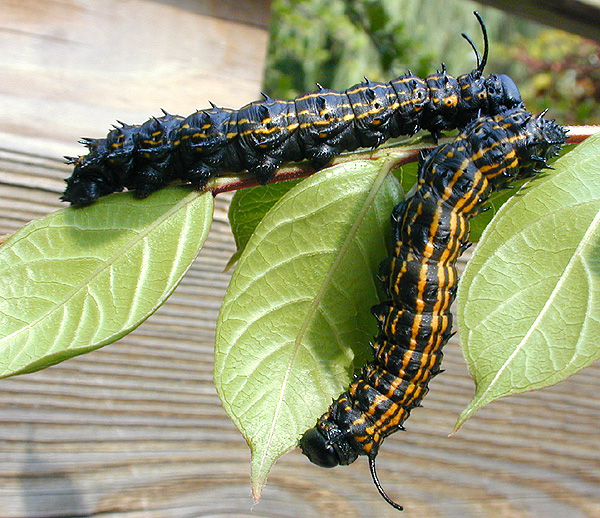
Anisota senatoria, courtesy of Wasil,
Forsyth County, NC
in the vicinity of Winston-Salem, August 23, 2003.
Winter diapause is in the pupal stage in shallow (up to four inches deep), loosely constructed underground
chambers.
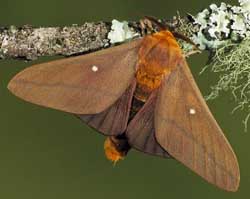
Anisota assimilis
M: 41-46mm; F: 48-50mm
lacks black areas (veins, am/pm lines) of dissimilis
lacks speckling of punctata
Mexico: Chihuahua; Sonora; Durango
Belize
|
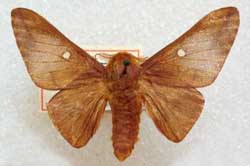
Anisota consularis
M: 29-36mm; F: 42-52mm
lighter brown than virginiensis
weak hyaline area
weak sprinkling of black dots
throughout Florida; eastern Georgia;
South Carolina; coastal areas of Alabama; Mississippi; Lousiana
|
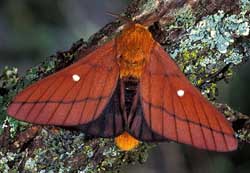
Anisota dissimilis
M: 31-36mm; F: 60-66mm
black veins and lines
Mexico: Durango; Hidalgo; Federal Distirct; Puebla; Veracruz; Jalisco; Oaxaca; Chiapas;
Belize
Guatemala: Sacatepequez
|
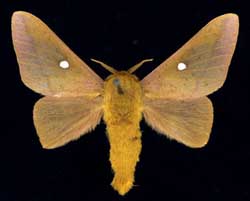
Anisota finlaysoni
M: 29-36mm; F: 44-54mm
lighter yellow-brown compared to orangey brown of senatoria
northeastern shore of Lake Ontario, Ontario (Toronto to Kingston), Canada
|
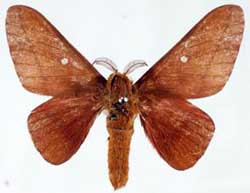
Anisota kendallorum
M: 38-47mm; F: 51-69mm
montane species
very similar to assimilis
fw pm line is reddish
no black scales on ventral hw
Mexico: Chiapas; Oaxaca
Belize
|
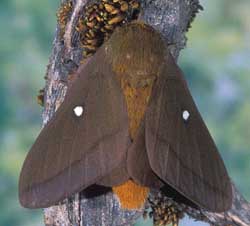
Anisota leucostygma
MFWL: 21-23mm
smokey-grey-brown ground colour
no black on abdomen
Mexico: Oaxaca
Guatemala
|
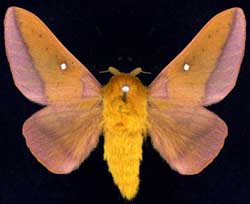
Anisota manitobensis
M: 39-41mm; F: 45-53mm
fw with pinkish cast
males without hyaline area
reduced black speckling
south-central Manitoba, Canada
?? North Dakota; Wisconsin
|
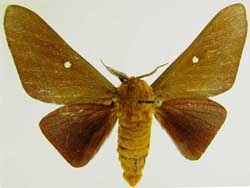
Anisota oslari
M: 43-54mm; F: 54-73mm
brown fws quite triangular
hindwings are dark
southeastern Arizona; New Mexico; southwestern Colorado; western Texas
Mexico: Sonora
Belize
|
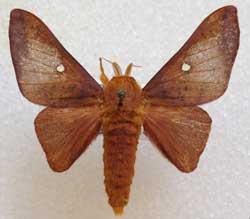
Anisota peigleri
M: 31-36mm; F: 46-58mm
moderate elevations
dry scrub oak forests
may be southernmost variation of senatoria
southern Ky to central Fl
|
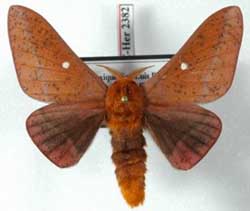
Anisota punctata
1365m
abdomen black, hw dull rose,
considerable speckling on fw
difuse grey fw pm line
Mexico: San Luis Potosi; Nuevo Leon; Sierra Madre Oriental
Belize
|
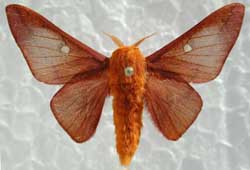
Anisota senatoria
M: 31-37mm; F: 45-59mm
southern Me to central Ga
west to central Mn to east Tx
extreme southcentral
Ontario, Canada, along northern shore of Lake Erie;
southern shore of Lake Ontario
|
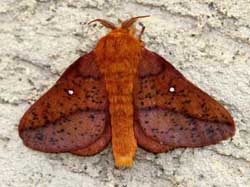
Anisota stigma
M: 36-48mm; F: 52-75mm
extensive speckling
eastern half US from southern NH to central Fl
extreme southern Ontario, Canada, along northern shore of Lake Erie
|
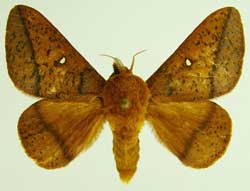
Anisota stigma fuscosa
M: 35-45mm; F: 47-60mm
possible color variation of stigma
brown ground colour as opposed to reddish-orangey brown of stigma
eastern third of Texas
|
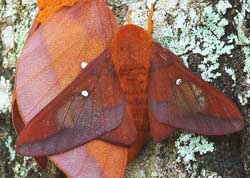
Anisota virginiensis
M: 29-36mm; F: 43-51mm
male gc red brown to burgundy-maroon
strong hyaline area
Nova Scotia west to Manitoba
Me to Mn to central Fl to east Tx
|
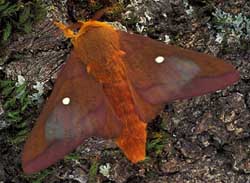
Anisota virginiensis discolor
M: 27-37mm; F: 42-66mm
possibly just a brownish form of virginiensis
southeastern Texas through Louisiana
|
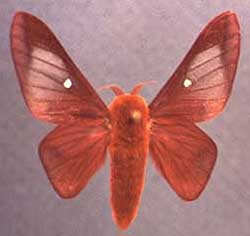
Anisota virginiensis pellucida
M: 27-37mm; F: 44-53mm
deeper reddish-brown gc
possibly a color morph of virginiensis
La to northern half Fl
|
P indicates a photograph is available. The first country/state listed is the type locality.
Listing of Anisota
N disjaliscana Brechlin & Meister, 2014
Mexico: Jalisco
N dismexicana Brechlin & Meister, 2014
Mexico: Mexico
N suprema Edwards, 1884, removed from synonymy with dissimilis by Brechlin & Meister, 2014
Mexico: Veracruz
P assimilis (Druce, 1886)
Mexico: Sonora,
Belize
P consularis Dyar, 1896, Florida, Southeastern U.S.
P dissimilis (Boisduval, 1872)
Mexico: Oaxaca,
Belize,
Guatemala
suprema, H. Edwards, 1884, Mexico: Veracruz, is a synonym for dissimilis; given full species status in 2014 by Brechlin & Meister
P finlaysoni Riotte, 1969, northeastern shore of Lake Ontario, Canada; Minnesota, Wisconsin
P kendallorum Lemaire, 1987
Mexico,
Belize
P leucostygma (Boisduval, 1872)
Mexico,
Guatemala
P manitobensis McDunnough, 1921, Manitoba, Canada; North Dakota, Wisconsin
P oslari W. Rothschild, 1907, Arizona, New Mexico, Colorado, Texas into
Mexico and
Belize
skinneri, C. R. Biedermann, 1908, Arizona, is a synonym for oslari
neomexicana, Brehme, 1909, New Mexico, is a synonym for oslari
P peigleri Riotte, 1975 South Carolina, Kentucky to Florida
P punctata Riotte & Peigler, 1981
Mexico,
Belize
P senatoria (J. E. Smith, 1797) Louisiana, eastern half of U.S.; Ontario, southern Canada
P stigma (Fabricius, 1775) eastern half of U.S., southern Canada
P stigma fuscosa Ferguson, 1971, Texas
P virginiensis (Drury, 1773) Virginia, eastern 2/3rds southern Canada and U.S.
P virginiensis discolor Ferguson, 1971, Texas to Louisiana
P virginiensis pellucida J. E. Smith, 1797, Louisiana to Florida
Use your browser "Back" button to return to the previous page.


